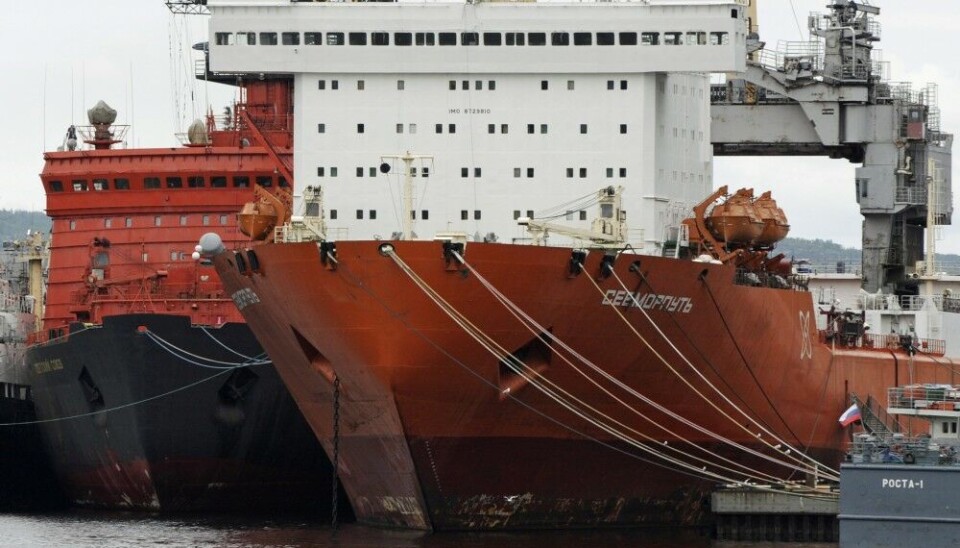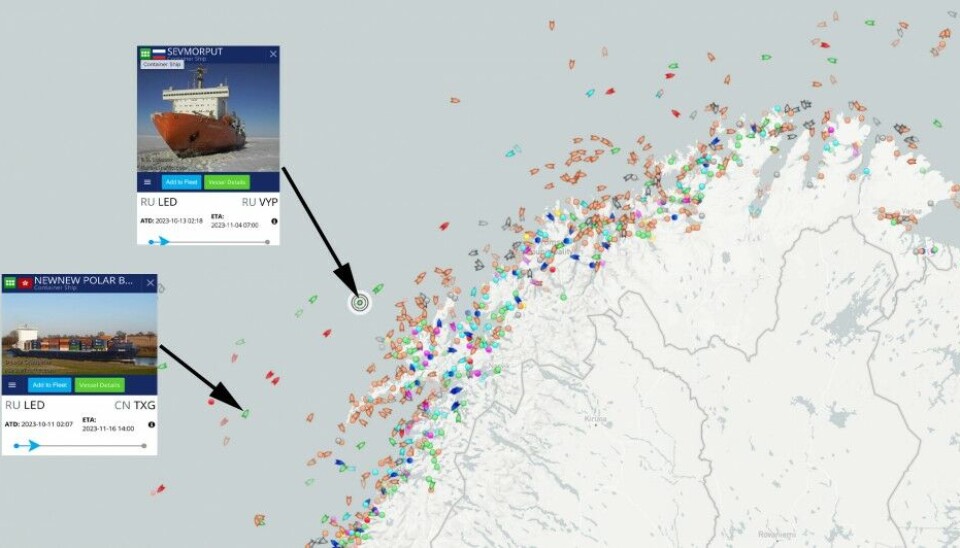
Russian, Chinese ships spotlighted by Finnish police after pipeline damage, are now pairing up outside northern Norway
The Sevmorput and Newnew Polar Bear sailed over the Balticconnector and the telecom cable in pair at the time the damage occurred. Now, they are following each other outside northern Norway, en route to Asia via the northern coast of Siberia.
Finland’s National Bureau of Investigation said in a statement on Tuesday it had launched an investigation on specific vessels that sailed in the area during the gas pipeline incident on October 7.
Two ships are mentioned by name; the Russian Rosatomflot-operated Sevmorput and the Chinese container carrier Newnew Polar Bear.
“The vessels in the area at the time of the incident have been established from open sources. Investigation measures have been focused on several vessels, such as Newnew Polarbear and Sevmorput, but also on others which according to data have been in the area at the time of the damage,” states Detective Superintendent Risto Lohi from the National Bureau of Investigation.
“In addition to the movements of the ships, their backgrounds and previous activities are investigated, in cooperation with the authorities of other states,” Lohi added.
A playback of shipping data for October 7 is shown in the tweet below.
At the time of damage to Balticconnector and comms-cable E-finest two ships passed these and the later military exclusion zones.Sevmorput, powerful, sturdy ice-breaker, Russian, military-affiliated.Newnew Polar Bear, Chinese, ice-capable, traffic Russia.No other ship fit. pic.twitter.com/daG3EnxZGF
The two ships were then heading towards St. Petersburg. On the 11 and 13 of October, they departed on a return voyage heading north towards the Europe-Asia shortcut via the Arctic.
By Wednesday morning, the Sevmorput and Newnew Polar Bear are crossing the Arctic Circle outside northern Norway. The Chinese vessel is a few hours behind the Russian.
Norway monitors
“We can’t go into detail about the two vessels,” says Corporal Jonny Karlsen, spokesperson with the Norwegian Joint Headquarters when asked by the Barents Observer about measures taken to monitor the current movements along the coast of Norway, waters that are packed with subsea pipelines and data cables.
He adds that the Norwegian Armed Forces together with the police raised alert readiness in late 2022.
As previously reported by the Barents Observer, the Sevmorput is sailing a subsidized voyage aimed at boosting cargo traffic between Russia’s Far Eastern regions and St. Petersburg.
The nuclear-powered ship is well-known in the Arctic and is frequently used by the Northern Fleet and other military structures to bring arms stuff to Arctic bases and test sites.
Hong Kong is destination for the Newnew Polar Bear, according to the vessel’s permit to sail north of Russia issued by Rosatom’s Northern Sea Route Administration. The permit, valid until October 31, allows the vessel to sail with icebreaker assistance, and the Sevmorput is likely the icebreaker in question on this voyage.

According to Reuters, authorities responsible for Sevmorput denied that one of its ships had been involved in the damage of the subsea communication cable or pipeline between Finland and Estonia.
“High priority”
Jonny Karlsen says protection of oil and gas installations in the North Sea has high priority.
“The presence and patrolling of the armed forces make it harder to carry out covert sabotage actions against the shelf.”
Although Norway doesn’t see any direct threats, awareness is high.
“[Norway’s] Defense forces reprioritise part of its activities, especially to maritime surveillance, with increased operative availability on navy ships and the air force,” Karlsen says.
He underlines that some of the operations can’t be disclosed to the public.
“We make several measures and adjustments that are not visible, or that we can tell about.”
NATO awareness
Also the other Nordic countries and NATO have in recent years highlighted the danger of Russian hybrid operations, like damage to subsea data cables and pipelines. The fear got renewed attention after the Nord Stream gas pipelines were damaged near Bornholm in the Baltic Sea in September last year.
In an interview with the Barents Observer, Deputy Commander at NATO’s JFC Norfolk, Rear Admiral Tim Henry, assured that NATO has a good situation awareness to protect subsea cables.
“Do I have the means to protect them? Of course, we have the means. The answer is yes. As a military person, yes. Making it impossible for anyone to operate without us knowing it, and understanding what they are doing. We have a good understanding of what is going on in our area of responsibility, yes,” Henry said.
Following the sabotage of the Nord Stream pipeline, NATO created a center at its headquarters in Brussels to protect critical undersea infrastructure. Norway, in cooperation with other allies, deployed extra navy resources to the North Sea region where a web of gas pipelines connects offshore installations with processing plants in Norway, and Great Britain and pumps natural gas to continental Europe.
Swedish alarm
On Tuesday, it also became clear that a telecom cable on the seabed between Sweden and Estonia was damaged about the same time as the damage to the pipeline from Finland to Estonia happened.














